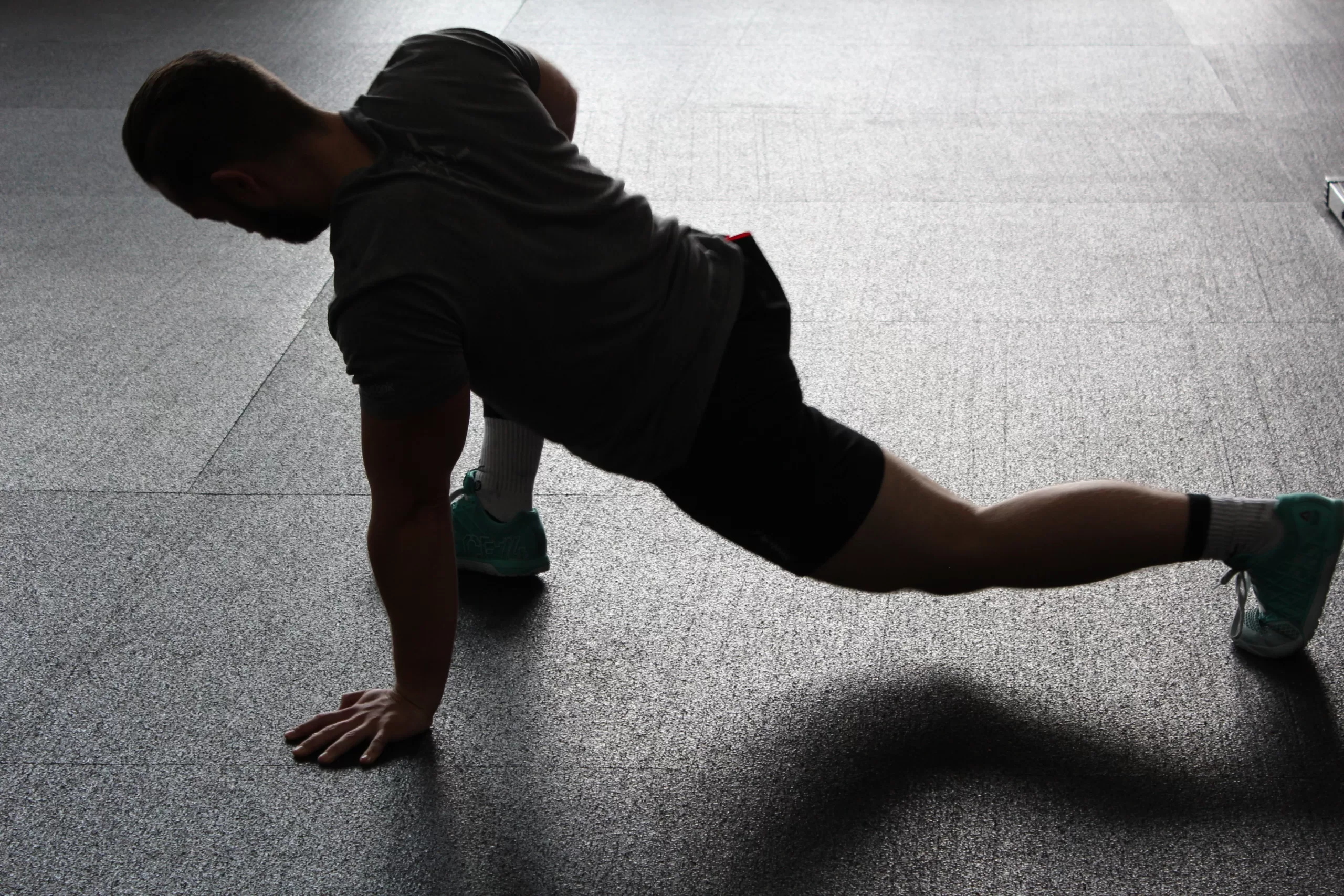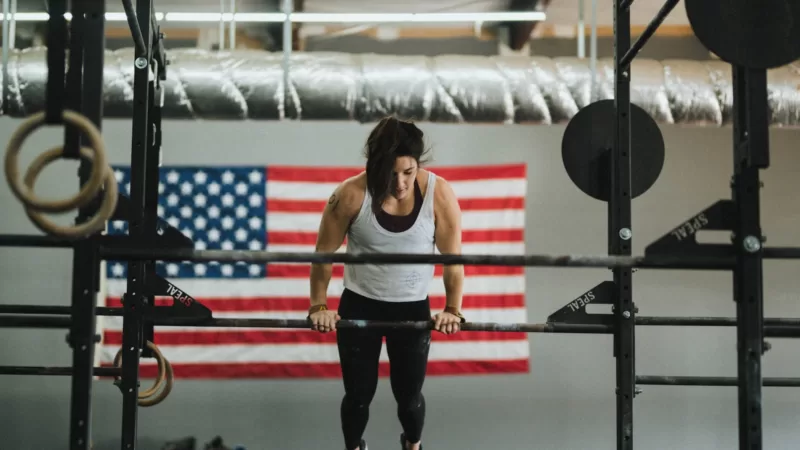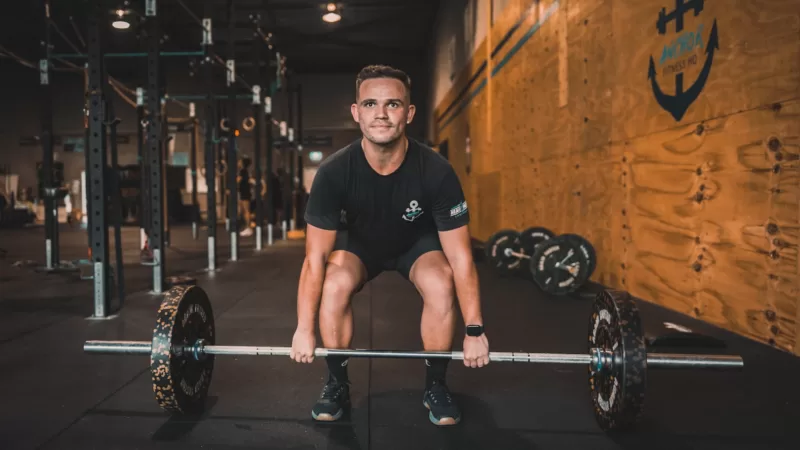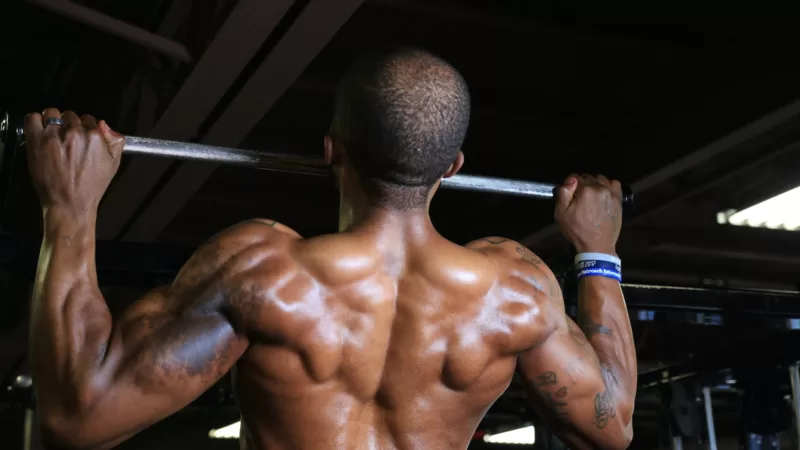CrossFit Flexibility Mastery: Unlocking Success

Are you ready to take your CrossFit training to the next level? If so, it’s time to talk about the often overlooked but incredibly important aspect of stretching for functional fitness mobility. Stretching is not just a warm-up routine or an afterthought; it is a crucial component that can make all the difference in your performance and overall success in CrossFit exercises, including the overhead squat.
Many people focus solely on strength training, building muscle, and improving endurance in their fitness routines. However, neglecting flexibility can lead to limited range of motion and increased risk of injury. Incorporating proper stretching techniques into your functional fitness routine can enhance your flexibility and mobility, allowing you to perform functional movements with better form and efficiency.
Static stretching is particularly beneficial for CrossFit athletes as it helps improve functional fitness mobility and increase blood flow. By understanding the importance of soft tissue work and making it a priority in your exercise regimen, you can optimize your performance while reducing the chances of setbacks due to injuries.
So let’s dive deeper into the world of stretching in CrossFit training for functional fitness mobility. We’ll explore different types of stretches, their benefits, and how they fit into your overall exercise routine at a normal gym. Get ready to unlock new levels of flexibility that will undoubtedly elevate your CrossFit game for athletes!
Understanding the Role of Flexibility in CrossFit Performance
Flexibility is a crucial component of functional fitness mobility and strength training for athletes. It goes beyond simply being able to touch your toes or do a split; it plays a vital role in enhancing your overall ability to excel in various CrossFit workouts. Let’s delve into why flexibility is so important and how it can directly impact your results, making them easier to achieve.
Enhanced Range of Motion for Optimal Movements
One of the key benefits of improved flexibility in functional fitness is the ability to achieve a greater range of motion during exercises at the gym. In CrossFit, movements like squats and overhead presses require significant mobilization in various joints, such as the hips, shoulders, and ankles. With increased flexibility, you’ll be able to perform these movements with better form and efficiency, completing more reps.
Imagine trying to squat in the gym with tight hip flexors or limited ankle mobility – it would not only compromise your functional fitness technique but also hinder your ability to generate power and strength. On the other hand, having good flexibility allows you to reach deeper into squats, activate more muscle groups effectively through joint mobilization, and ultimately lift heavier weights with ease.
Overcoming Limitations for Proper Form
Proper form is essential in CrossFit exercises to prevent injuries and optimize performance in the gym. However, lack of flexibility can significantly impede your ability to maintain proper form throughout different movements, affecting functional fitness mobility. For instance, tight hamstrings may cause rounding of the back during deadlifts or limit the depth of your squat, requiring ROM and mobilization.
By focusing on improving flexibility through targeted stretches and mobilization exercises specific to problem areas (such as hip openers or shoulder stretches), you can overcome limitations in range of motion (ROM) and execute movements correctly while minimizing strain on the back and vulnerable joints and muscles.
Unlocking Progress Potential
In CrossFit training, functional fitness mobility is key – whether it’s increasing weights lifted, mastering new skills like handstands or muscle-ups, or beating personal records in timed workouts. However, limited flexibility and lack of mobilization can become a roadblock to achieving these goals, especially when it comes to the back.
When your body lacks functional fitness mobility and the necessary flexibility, you may find it challenging to perform certain back movements efficiently. This can lead to frustration and slower progress. By dedicating time to improving flexibility and functional fitness mobility, you’ll create a solid foundation for continuous growth in your CrossFit journey.
Developing Flexibility: A Must for CrossFit Success
To achieve optimal results in CrossFit, developing flexibility and functional fitness should be an integral part of your training routine. Here are some effective strategies to enhance your flexibility and strengthen your back.
- Incorporate dynamic warm-up exercises that target major muscle groups, joints, flexibility training, and functional fitness before each workout to prevent injury and improve performance.
- Include flexibility training exercises, such as static stretching, at the end of your functional fitness sessions, focusing on areas that tend to be tight or restricted.
- Practice yoga or Pilates regularly to improve overall flexibility and mobility in functional fitness.
- Utilize foam rolling or self-myofascial release techniques for functional fitness to alleviate muscle tension and increase range of motion.
- Seek guidance from a qualified coach or physical therapist who can provide personalized functional fitness stretching routines tailored to your specific needs.
Remember, Rome wasn’t built in a day – improving flexibility and functional fitness takes time and consistent effort.
The Impact of Proper Stretching Techniques on CrossFit Results
Dynamic Stretches: Boosting Power Output
Dynamic stretches are a game-changer for functional fitness. Unlike static stretches, which involve holding a stretch for an extended period, dynamic stretches involve continuous movement that mimics the actions you’ll perform during your functional fitness workout. These stretches not only increase flexibility but also help activate and warm up the muscles, improving power output for functional fitness exercises.
Here are some examples of dynamic stretches to incorporate into your CrossFit routine for functional fitness.
- Functional fitness leg swings: Stand next to a wall or support and swing one leg forward and backward, gradually increasing the range of motion.
- Arm circles are a great exercise for functional fitness. Extend your arms out to the sides and make circular motions with them, gradually increasing the size of the circles.
- High knees: While jogging in place, lift each knee as high as possible towards your chest.
By incorporating dynamic stretching into your warm-up routine, you’ll prime your muscles for optimal performance during your CrossFit workouts.
Static Stretches: Enhancing Muscle Recovery
After completing a grueling CrossFit session, it’s crucial to give your body time to recover properly. This is where static stretches come in handy. Unlike dynamic stretches, static stretches involve holding a position for an extended period without any movement. These post-workout stretches help relax and lengthen tight muscles while reducing post-exercise soreness.
Here are some examples of static stretches that can aid in muscle recovery:
- Hamstring stretch: Sit on the ground with one leg extended straight out in front of you and reach forward toward your toes.
- Quadriceps stretch: Stand tall and pull one foot towards your glutes, holding onto it with one hand while keeping proper balance.
- Chest stretch: Find a doorway or corner where you can place both hands on either side at shoulder height and lean forward gently.
Incorporating static stretches into your cool-down routine will help your muscles recover faster and reduce the risk of post-workout stiffness.
Flexibility: The Key to Endurance and Strength Gains
Flexibility plays a vital role in CrossFit, as it allows you to perform movements with a full range of motion. By implementing effective stretching techniques, you can improve your flexibility, leading to enhanced endurance and strength gains.
When your muscles are flexible, they can move through a greater range of motion without strain or injury. This flexibility translates into improved performance during exercises like squats, deadlifts, and overhead presses. Increased flexibility enables better body positioning and alignment, reducing the risk of compensatory movements that can lead to imbalances or injuries.
To enhance your flexibility for CrossFit:
- Incorporate regular stretching sessions into your training schedule.
- Focus on specific muscle groups that tend to be tight in CrossFit athletes, such as hip flexors, hamstrings, and shoulders.
- Use foam rollers or lacrosse balls for self-myofascial release (SMR) to target tight areas before stretching.

How Mobility Exercises Enhance Power and Prevent Injury in CrossFit
Improved Range of Motion for Better Performance
Mobility exercises play a crucial role in enhancing performance in CrossFit by targeting specific joints and improving their range of motion. When your joints have a greater range of motion, you can perform movements more effectively and efficiently. For example, if you have limited shoulder mobility, it can significantly impact your ability to perform exercises like overhead presses or snatches. By incorporating mobility exercises that focus on the shoulders, such as band pull-aparts or shoulder dislocations, you can increase your range of motion and optimize your performance.
Enhanced Power Output through Efficient Movement Patterns
Increased joint mobility not only allows for better movement but also leads to enhanced power output. When your joints are mobile and flexible, you can engage more muscles during each movement, resulting in increased strength and power generation. For instance, having good hip mobility enables you to generate explosive power during movements like squats or deadlifts. By regularly performing hip-opening exercises like deep lunges or pigeon stretches, you can unlock the full potential of your hips and maximize your power output.
Reduced Risk of Injury with Strengthened Supporting Muscles
Engaging in regular mobility exercises is essential for preventing injuries in CrossFit. These exercises not only improve joint flexibility but also strengthen the supporting muscles and ligaments around them. Stronger muscles provide better stability and support during dynamic movements, reducing the risk of strains or tears. For instance, ankle mobility exercises like calf raises or ankle circles help strengthen the surrounding muscles while increasing flexibility, minimizing the chances of ankle sprains during activities such as box jumps or running.
Maintaining Proper Form During Complex Movements
Complex movements like Olympic lifts require precise form to ensure safety and optimal performance. Mobility exercises are vital for maintaining proper form during these intricate movements. They help address any restrictions or imbalances that may hinder correct technique execution. For example, limited thoracic spine mobility can affect your ability to perform a proper front rack position in exercises like cleans or thrusters. By incorporating exercises that focus on improving thoracic mobility, such as foam rolling or thoracic extensions, you can maintain the correct posture and execute these movements with proper form.
Exploring the Benefits of Mobility Routines in CrossFit Training
Optimizing Body Mechanics for Effortless Functional Movements
Mobility routines play a crucial role in enhancing your CrossFit performance by optimizing body mechanics. These routines consist of a variety of mobility exercises and drills specifically designed to increase joint mobility, flexibility, and range of motion. By incorporating these movements into your regular workouts, you can improve your ability to perform functional movements with ease.
Imagine effortlessly transitioning from one exercise to another, smoothly executing each movement without feeling restricted or limited by tight muscles or stiff joints. Mobility work helps break down those barriers by loosening up tight areas and improving overall flexibility. As a result, you’ll experience improved fluidity in your movements and reduced risk of injury.
Enhancing Agility, Balance, and Coordination
One of the key benefits of incorporating mobility routines into your CrossFit training is the enhancement of agility, balance, and coordination. These qualities are essential.
By regularly engaging in mobility work that targets specific areas such as hip mobility or overhead mobility, you can improve your ability to move efficiently during exercises like box jumps, kettlebell swings, or handstand push-ups. Increased joint mobility allows for better control over your body’s movements, leading to improved balance and coordination.
Improving Athletic Performance Inside and Outside the Gym
The advantages of mobility routines extend beyond the walls of the gym. Regularly incorporating these exercises into your training program can greatly enhance overall athletic performance both inside and outside the CrossFit box.
Improved flexibility gained through mobility work translates into increased power output during explosive movements like Olympic lifts or sprinting. Greater range of motion allows for more efficient muscle recruitment during exercises such as squats or deadlifts.
Beyond enhancing performance within structured workouts, increased joint mobility also carries over into everyday life activities. Whether it’s reaching overhead to grab an item from a high shelf or bending down to tie your shoes, improved flexibility and mobility make these tasks easier and more comfortable.
Preventing Muscle Imbalances and Promoting Joint Health
Another significant benefit of incorporating mobility routines into your CrossFit training is the prevention of muscle imbalances and the promotion of joint health. Over time, repetitive movements and intense workouts can lead to tight muscles, which may result in imbalances that affect performance and increase the risk of injury.
Mobility exercises specifically target areas prone to tightness, helping to alleviate muscular imbalances. By regularly engaging in mobility work, you can correct these imbalances before they become problematic, ensuring proper muscle activation during workouts.
Moreover, mobility routines promote joint health by reducing stiffness and increasing synovial fluid circulation. This lubrication helps nourish the joints with essential nutrients while also providing shock absorption during high-impact movements.
Incorporating mobility work into your CrossFit routine not only improves your performance but also supports overall joint health for long-term well-being.
So why wait? Start integrating mobility exercises into your CrossFit training today and experience the numerous benefits they bring.
Enhancing Range of Motion for Improved CrossFit Performance
The Importance of Flexibility in CrossFit
Flexibility is a key component of any successful CrossFit program. It not only helps prevent injuries but also plays a crucial role in enhancing performance. By expanding your range of motion through targeted stretching exercises, you can take your CrossFit game to the next level.
Efficient Movement Patterns and Technique
One of the primary benefits of increased range of motion is the ability to perform movements more efficiently. When you have good flexibility in your joints, you can execute exercises like overhead squats with proper form and full range. This allows you to engage the correct muscles and maximize power output during workouts. With improved technique, you’ll be able to lift heavier weights while maintaining control and stability.
Stability During Challenging Exercises
CrossFit often involves challenging movements that require stability and balance. Having greater flexibility in your joints translates into improved stability during exercises like pistols or handstand push-ups. These movements demand control over multiple planes of motion, and being flexible allows you to maintain proper alignment throughout the entire range of motion. As a result, you’ll be less prone to injury and able to perform these exercises more effectively.
Functional Fitness Benefits
CrossFit aims to improve overall functional fitness – the ability to perform everyday tasks with ease and efficiency. Focusing on enhancing range of motion contributes significantly to this goal. By increasing flexibility through targeted drills and stretches, you develop strength across a wider range, allowing for better movement quality in daily life activities as well.
Recovery and Injury Prevention
Improving flexibility also aids in post-workout recovery and injury prevention. When your muscles are tight or restricted due to limited range of motion, they are more susceptible to strains or tears during intense workouts. By regularly incorporating stretching exercises into your routine, you promote blood flow to the muscles and increase their flexibility. This helps reduce muscle soreness, improve recovery time, and minimize the risk of injuries.
Maximizing Flexibility Gains
To make the most of your flexibility gains in CrossFit, it’s important to focus on both static and dynamic stretches. Static stretches involve holding a position for an extended period, while dynamic stretches involve moving through a full range of motion. Incorporating both types into your warm-up routine can help prepare your muscles and joints for the demands of CrossFit workouts.
Here are some examples of stretching exercises that can enhance your range of motion:
- Hip flexor stretch: Kneel on one knee with the other foot planted forward. Lean forward until you feel a stretch in the front of your hip.
- Shoulder mobility drills: Perform arm circles or use resistance bands to improve shoulder rotation and mobility.
- Hamstring stretch: Sit on the floor with one leg extended in front. Reach towards your toes while keeping your back straight.
Remember, consistency is key. Make sure to incorporate these exercises into your regular workout routine and gradually increase intensity over time.
Addressing Limitations: Overcoming Tightness in Shoulders and Hips
Why Tight Shoulders and Hips Matter in CrossFit
Tight shoulders and hips are common limitations that can hinder your CrossFit performance. These areas play a crucial role in various movements, and if they lack flexibility, you may struggle to achieve optimal technique, range of motion, and overall strength. However, with targeted stretching exercises, you can alleviate tightness, improve mobility, reduce the risk of injury, and unlock your full potential in CrossFit.
Enhancing Overhead Movements with Shoulder Mobility
Shoulder tightness can restrict your ability to perform overhead movements effectively. Snatches, thrusters, push presses—these dynamic exercises rely on proper shoulder mobility to execute them safely and efficiently. When your shoulders are tight, it becomes challenging to maintain the necessary angle for these movements. As a result, you may experience pain or difficulty locking out the weight overhead.
To address shoulder tightness:
- Warm up: Begin each workout with a warm-up routine that includes shoulder stretches such as arm circles or wall slides.
- Stretch regularly: Incorporate static stretches like doorway stretches or shoulder dislocations into your daily routine.
- Use mobility tools: Foam rollers or lacrosse balls can help release tension in the muscles surrounding the shoulders.
- Strengthen weak points: Focus on exercises that target the upper body muscles responsible for stabilizing and supporting shoulder movement.
By consistently working on improving shoulder mobility through stretching exercises and strengthening weak points around this joint, you’ll find yourself better equipped to handle overhead movements with ease.
Unlocking Squat Depth by Addressing Hip Tightness
Hip tightness is another limitation that can hinder your performance in CrossFit workouts involving squats or deadlifts. Without proper hip flexibility, achieving adequate squat depth becomes challenging. This not only affects your form but also limits how much weight you can safely lift. By addressing hip tightness, you can enhance your lower body strength and technique.
To overcome hip tightness:
- Warm up: Begin with a dynamic warm-up routine that includes exercises like leg swings or hip circles.
- Stretch regularly: Incorporate static stretches such as pigeon pose, butterfly stretch, or deep squats into your daily routine to open up the hips.
- Mobilize the joints: Use mobility tools like resistance bands or foam rollers to target the muscles around the hips and improve their range of motion.
- Engage in hip-opening exercises: Include movements like sumo squats, glute bridges, or lunges in your training program to strengthen and increase flexibility in the hips.
By consistently focusing on improving hip flexibility through stretching exercises and engaging in specific workouts that target this area, you’ll find yourself achieving better squat depth and experiencing improved overall performance.
Conclusion
To maximize your potential in CrossFit, it is crucial to prioritize flexibility and mobility. Understanding the role of flexibility in CrossFit performance is key. Proper stretching techniques have a significant impact on your results, allowing you to push yourself further and prevent injuries. Incorporating mobility exercises into your routine enhances power and reduces the risk of injury, enabling you to excel in CrossFit training.
By implementing mobility routines, you can experience numerous benefits in your CrossFit journey. These routines improve your range of motion, enabling you to perform movements more efficiently and effectively. Addressing limitations such as tightness in the shoulders and hips will allow you to overcome obstacles that may hinder progress.
In summary, focusing on flexibility and mobility is essential for unlocking your full potential in CrossFit. By incorporating proper stretching techniques and mobility exercises into your training routine, you can enhance your performance while minimizing the risk of injury.
Take action now by integrating specific flexibility exercises into each workout session. Embrace a proactive approach towards improving your range of motion and addressing any limitations hindering your progress. With dedication and consistency, you can optimize your CrossFit performance through enhanced flexibility and mobility.
FAQs
Q: How often should I incorporate stretching into my CrossFit routine?
Stretching should be incorporated before every workout session as part of a warm-up routine. Consider dedicating separate sessions solely for stretching at least two to three times per week.
Q: Can improved flexibility really help prevent injuries during CrossFit?
Yes! Improved flexibility helps prepare muscles for intense movements while reducing the risk of strains or tears. It allows for better body alignment during exercises, decreasing stress on joints and tendons.
Q: Are there any specific stretches that target common areas of tightness in CrossFitters?
Yes! For tight shoulders, try shoulder dislocations with a resistance band or doorway stretches. To address hip tightness, incorporate exercises like pigeon pose or hip flexor stretches.
Q: How long should I hold each stretch?
Hold each stretch for 15 to 30 seconds, focusing on deep breathing and allowing the muscle to relax. Avoid bouncing or forcing the stretch beyond your comfort level.
Q: Can improving my flexibility really enhance my CrossFit performance?
Absolutely! Increased flexibility allows for a greater range of motion, enabling you to perform exercises with better form and efficiency. This can lead to improved strength, power, and overall performance in CrossFit.

Dave Carter
Dave serves as the head writer and chief content curator for CrossFitopedia.com, the premier destination for CrossFit enthusiasts seeking to enhance their fitness journeys.






